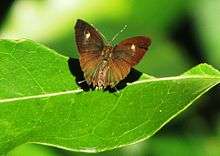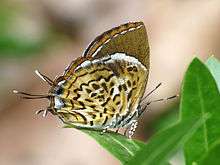Rathinda amor
| Monkey Puzzle | |
|---|---|
| | |
| Scientific classification | |
| Kingdom: | Animalia |
| Phylum: | Arthropoda |
| Class: | Insecta |
| Order: | Lepidoptera |
| Family: | Lycaenidae |
| Genus: | Rathinda |
| Species: | R. amor |
| Binomial name | |
| Rathinda amor (Fabricius, 1775) | |
The Monkey Puzzle, Rathinda amor (Fabricius) 1775 is a small lycaenid or blue butterfly found in south Asia.
Distribution
Western Ghats, South Indian plains (as far north as Bangalore), Orissa and Ganjam districts to Calcutta, Assam, Bangladesh and Sri Lanka.
Status
Not Rare in India. It is common and present in all the Western Ghat districts of Kerala, Karnataka, Tamil Nadu and Goa. It is common but not found in all the Ghat districts of Maharashtra and does not occur in Gujarat at all (Gaonkar). However, there are recent records confirmed from Gujarat as far as up to Surat.
Description

- Sexes alike. Wingspan - 26 to 28 mm.
- Upperside - The butterfly is dark brown. It has a white-spot end cell. It has narrow white spots on 2 and 3 which form a short band on the forewing. On the UPH it has two black tornal spots and narrow dark reddish spot above them.
- Underside - The butterfly is white to dark yellowish brown. Forewing has irregular dark basal markings with a curved white discal line. The apical two-fifths are a rich dark brown colour. The hindwing has a silvery margin with many irregular black lines and spots within. It has three tails, being 2 mm, 6 mm and 2.5 mm in length.

Habits
This butterfly is found in jungle areas of moderate to heavy rainfall - both, in heavy forest and scrub. The butterfly occurs below 900 meters or so. It keeps to undergrowth and can be seen along forest paths and in clearings.
The butterfly has a weak flight, it stays low and does not fly for long without alighting. Its method of alighting is interesting - as soon as it lands, it turns around and waggles its tail filaments, it also sidesteps for a while - all this is apparently to confuse a predator as to which side is the head. This is a likely reason that the first naturalists may have named the species the Monkey Puzzle.
Life cycle

Larva
The larva is unusual for a Lycaenid. It is pale green in colour and has a long line of fleshy protrusions along the back. The protuberances near the head are branched in two. On the fourth segment the protuberance is straight and has a sharp point. The last segments have two protuberances each curved outwards. The last protuberance is curved outwards and upwards. According to Evans, the larva supposedly resembles a monkey's head hence the name.
Pupa
The pupa is green and turns brown as it nears maturity. The back of the abdomen is pink and smooth. The pupa is attached by one point only - by a long stalk at the tail.
Food Plants
The butterfly has a number of food plants from families Rubiaceae, Dipterocarpeae, Euphorbiaceae, Loranthaceae, Sapindaceae and Myrtaceae. Mangifera indica, Meiogyne pannosa.[1]

See also
List of butterflies of India (Lycaenidae)
References
- ↑ Kalesh, S & S K Prakash (2007). "Additions of the larval host plants of butterflies of the Western Ghats, Kerala, Southern India (Rhopalocera, Lepidoptera): Part 1". Journal of the Bombay Natural History Society. 104 (2): 235–238.
- Evans, W.H. (1932). The Identification of Indian Butterflies (2nd ed.). Mumbai, India: Bombay Natural History Society.
- Gaonkar, Harish (1996). Butterflies of the Western Ghats, India (including Sri Lanka) - A Biodiversity Assessment of a Threatened Mountain System. Bangalore, India: Centre for Ecological Sciences.
- Gay, Thomas; Kehimkar, Isaac David; Punetha, Jagdish Chandra (1992). Common Butterflies of India. Nature Guides. Bombay, India: World Wide Fund for Nature-India by Oxford University Press. ISBN 978-0195631647.
- Haribal, Meena (1992). The Butterflies of Sikkim Himalaya and Their Natural History. Gangtok, Sikkim, India: Sikkim Nature Conservation Foundation.
- Kunte, Krushnamegh (2000). Butterflies of Peninsular India. India, A Lifescape. Hyderabad, India: Universities Press. ISBN 978-8173713545.
- Wynter-Blyth, Mark Alexander (1957). Butterflies of the Indian Region. Bombay, India: Bombay Natural History Society. ISBN 978-8170192329.
- Shihan, T.R. (2016) A Photographic Guide to the Butterflies of Bangladesh. Butterfly Reintroduction Farm, Chuadanga, Bangladesh.